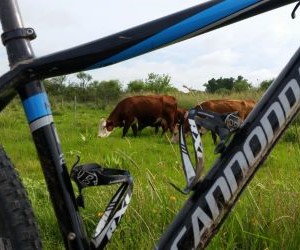Learn how to deal with punctures on long rides with prevention tips, repair techniques, and smart gear choices to keep rolling without stress.
WHAT ARE THE BEST CYCLING-FRIENDLY CAMPING TIPS?
Combining cycling and camping—better known as bikepacking—is one of the most rewarding ways to explore the outdoors. But it requires more than just loading your tent onto a bike rack and riding off into the sunset. Successful cycling-friendly camping blends lightweight packing, smart route planning, nutrition, weather awareness, and gear selection. Whether you're heading out for a weekend or a multi-day journey, this guide covers the essential tips that will help you stay safe, well-fed, dry, and ready to ride day after day.

Pack smart and light
Balance weight, space, and ride comfort
One of the biggest challenges in cycling-friendly camping is carrying everything you need without overloading your bike. The goal is to pack light but not under-prepare. Every item must earn its place. Choose multi-purpose gear that’s lightweight, compact, and durable.
Instead of bulky panniers, many bikepackers prefer frame bags, seat packs, and handlebar rolls to evenly distribute weight and maintain aerodynamics. Ultralight tents or bivvy sacks, compact sleeping pads, and high-loft sleeping bags are must-haves. Don’t forget a basic toolkit, tire repair gear, and a power bank for your devices.
Pack your heaviest items low and centered (in the frame bag) to maintain bike handling. Use compression sacks for clothing and food. Choose quick-drying, merino or synthetic clothes to save weight on spares. Always bring at least one insulation layer and a rain shell, regardless of forecast.
Use frame, saddle, and handlebar bags to balance weight
Bring an ultralight tent or bivvy sack and inflatable sleeping pad
Choose technical apparel—merino wool, synthetic, quick-dry
Pack a toolkit, tire levers, pump, multitool, and patch kit
Use dry bags and compression sacks to save space and stay organized
Your bike should feel stable, not sluggish. A good rule of thumb: if it doesn’t serve multiple purposes or add significant value, leave it behind.
Plan routes and campsites carefully
Navigation and shelter make or break your ride
Cycling-friendly camping starts long before the first pedal stroke. Planning your route is critical—not just for distance and elevation, but for water sources, food availability, and legal camping spots. Apps like Komoot, Ride with GPS, and Gaia GPS can help you find routes that suit your bike and fitness level while avoiding unsafe or overly technical terrain.
Stick to daily mileage that allows you to enjoy the ride and reach camp before sunset. 60–100 km is realistic for loaded bikes on mixed terrain. Research campgrounds, dispersed camping rules, and water refill points. Some regions allow wild camping; others require designated sites or permits.
Scout backup campsites in case of delays or weather issues. If you're traveling internationally, check whether stoves or fires are allowed. A lightweight stove and freeze-dried meals are great for self-sufficiency when grocery stores are scarce.
Use Komoot, Gaia GPS, or Ride with GPS to map bike-specific routes
Check elevation gain, terrain type, and resupply points
Plan for 60–100 km per day, depending on terrain and weather
Identify legal camping areas, backcountry permits, and water access
Always have a plan B campsite or shelter option
The goal is to ride with confidence, not guesswork. Smart planning saves energy, reduces stress, and keeps you out of trouble when things don’t go as planned.
Stay safe, fueled, and weather-ready
Cyclist-specific survival strategies
Bike camping puts you face-to-face with the elements—and your own limits. Safety starts with situational awareness. Always carry a backup navigation method (offline maps or paper), wear visible clothing, and tell someone your route. For remote rides, a GPS tracker or satellite communicator adds a critical safety net.
Fueling is essential. Unlike car camping, you’re burning thousands of calories per day. Pack calorie-dense, non-perishable snacks: trail mix, nut butters, energy bars, instant oatmeal, and electrolyte tablets. Replenish often to avoid the bonk. Drink regularly—many riders under-consume water when riding loaded bikes in cooler weather.
Weather is the wild card. Check forecasts, but be ready for anything. Carry waterproof bags, a rain jacket, thermal layers, and gloves. Learn to dry gear overnight and manage wet conditions without letting morale or safety slide.
Use offline maps and/or a GPS beacon for safety in remote areas
Tell a friend your route and check in when possible
Pack calorie-dense, non-refrigerated foods and electrolytes
Prepare for cold nights and wet weather with layers and dry bags
Practice setting up your tent in the dark or rain at home
Bike camping is freedom on two wheels—but freedom comes with responsibility. Staying safe, fed, and dry means you’ll enjoy the adventure and want to do it again (and again).
YOU MAY ALSO BE INTERESTED






